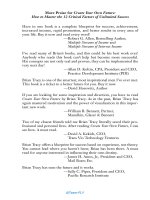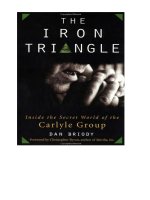John wiley sons forbes to the limits pushing yourself to the edge in adventure and in business
Bạn đang xem bản rút gọn của tài liệu. Xem và tải ngay bản đầy đủ của tài liệu tại đây (984.73 KB, 274 trang )
To the Limits
To the Limits
Pushing Yourself
to the Edge—
in Adventure
and in Business
James M. Clash
John Wiley & Sons, Inc.
Copyright © 2003 by Forbes Inc. and James M. Clash. All rights reserved.
FORBES is a registered trademark. Its use is pursuant to a license agreement
with Forbes Inc.
Published by John Wiley & Sons, Inc., Hoboken, New Jersey.
Published simultaneously in Canada.
No part of this publication may be reproduced, stored in a retrieval system,
or transmitted in any form or by any means, electronic, mechanical,
photocopying, recording, scanning, or otherwise, except as permitted under
Section 107 or 108 of the 1976 United States Copyright Act, without either
the prior written permission of the Publisher, or authorization through
payment of the appropriate per-copy fee to the Copyright Clearance Center,
Inc., 222 Rosewood Drive, Danvers, MA 01923, (978) 750-8400, fax (978)
750-4470, or on the web at www.copyright.com. Requests to the Publisher for
permission should be addressed to the Permissions Department, John Wiley &
Sons, Inc., 111 River Street, Hoboken, NJ 07030, (201) 748-6011, fax (201)
748-6008, e-mail:
Limit of Liability/Disclaimer of Warranty: While the publisher and
author have used their best efforts in preparing this book, they make no
representations or warranties with respect to the accuracy or completeness of
the contents of this book and specifically disclaim any implied warranties of
merchantability or fitness for a particular purpose. No warranty may be
created or extended by sales representatives or written sales materials. The
advice and strategies contained herein may not be suitable for your situation.
The publisher is not engaged in rendering professional services, and you
should consult a professional where appropriate. Neither the publisher nor
author shall be liable for any loss of profit or any other commercial damages,
including but not limited to special, incidental, consequential, or other
damages.
For general information on our other products and services please contact
our Customer Care Department within the United States at (800) 762-2974,
outside the United States at (317) 572-3993 or fax (317) 572-4002.
Wiley also publishes its books in a variety of electronic formats. Some content
that appears in print may not be available in electronic books. For more
information about Wiley products, visit our web site at www.wiley.com.
ISBN: 0-471-21093-5
Printed in the United States of America
10 9 8 7 6 5 4 3 2 1
This book is dedicated to two people very dear to me
who passed away in the summer of 2001: my mother,
Winifred, who lost her battle with colon cancer on July 4;
and Laury Minard, founding editor of Forbes Global,
who died climbing Mount Rainier on August 2.
Without their support and mentoring,
this would not have been possible.
Contents
xi
xv
Foreword by Tim Forbes
Introduction
1 Commercial Adventure Today
1
2 Because They’re There
7
Grand Teton: America’s Matterhorn
8
Mount Aconcagua: Shiver and Pray
12
The Matterhorn: Crowds in the Clouds
23
Mont Blanc: Monarch of the Alps
28
Mount Kilimanjaro: Wide as All the World
32
Mount Kosciusko: The Seventh Summit
40
3 Everest, According To . . .
43
Sir Edmund Hillary: Dean of Everest
45
Dick Bass: Father of Mountaineering
Adventure Travel
56
Conrad Anker: The Mallory Question
62
Jamling Norgay: Like Father, Like Son
65
Ed Viesturs: 8,000 Meters or Bust!
71
Lawrence Huntington: When to Say When
76
Robert Anderson: The Art of Guiding
81
vii
Contents
4 The Business of Adventure
Geoffrey Kent: Mr. Abercrombie, I Presume?
95
96
Robert Lutz: High on Speed
100
Farhad Vladi: Islands for Sale
103
Greg MacGillivray: IMAX Man
107
5 Tops and Bottoms of the World
111
Svalbard: The Long Arctic Night
113
The North Pole: A Different Kind of Cold War
117
Antarctica: Climbing with Penguins
122
The North Pole: Swimming with Santa
126
A Titanic Trip: Voyage to the Bottom of the Sea
130
Dead Sea: How Low Can You Go?
135
6 Racing with the Wind
139
Rick Mears: Four-Time Indy 500 Champ
140
Nazareth: Testing My Own Mettle
145
Skip Barber: Grand Prix Racing at Daytona
147
Fontana: 200 Miles per Hour or Bust!
151
Racing for Kids: Second Chance to Speed
156
Italy: Lamborghini at 200
162
Vintage Cars: Let Them Eat Dust
166
George Hall: Cigarette Boats and Hedge Funds
171
7 Adventures in Physics and Metaphysics
177
New Mexico: Ground Zero
178
Edward Teller: Father of the Hydrogen Bomb
180
Ham Radio: Vicarious Travels
194
Roger Bannister: Four Minutes to Fame
197
viii
Contents
Tommy Moe: Olympic Gold
202
Baker and Bruce: Cream of the Musical Crop
205
Survivor: Escape from the World Trade Center
211
8 Space: The Final Frontier
215
The Right Stuff: Tourists in Space
216
Buzz Aldrin: The View from Number 2
219
Dennis Tito: Executive in Space
225
Kathryn Sullivan: Spacewalker Turned CEO
230
Mach 2.6 in a MiG: ’Scuse Me While I Kiss
the Sky
235
241
243
253
Acknowledgments
Index
About the Author
ix
Foreword
“Life is not a dress rehearsal,” my father Malcolm would say
with an urgency and seriousness that left no doubt. He meant
it. And for him, one of the keys to a life fully lived was adventure. Flying a Sphinx-shaped hot air balloon over Cairo, riding a Harley-Davidson on Pakistan’s Karakoram Highway,
these were the sorts of experiences he most relished. That
same spirit, it seems to me, pervades this book, animating the
people who populate it, including, in particular, the author.
Through accounts of his own adventures in the mountains,
on race tracks, and at the polar regions and through his interviews with adventurers of many sorts, Jim Clash explores how
the human spirit is molded and uplifted by extreme pursuits.
In the process, he also suggests how the lessons of such experiences link back to the pragmatic world of business. Such connections are more common and often more direct than one
might initially suppose. Listen to Sir Edmund Hillary on his and
Tenzing Norgay’s pioneering ascent of Mount Everest: “. . . We
had challenges to overcome, which had never been seen before.
Nobody had ever been to the top. It meant that during the
whole expedition we had to establish the route ourselves . . . and
we had this constant concern that we didn’t know if it was physically possible to reach the summit.” Change a word here and
there, and he could be describing the struggles of an entrepreneur in a new field. That, too, is an adventure of sorts, and many
of the qualities of character that make for success in a start-up
xi
Foreword
business are likely similar to those that mark a Hillary or some of
the others represented here. But that is not particularly why
these stories are worthwhile reading. Rather, it is because they
shed some light on the nature of adventure itself and its irresistible appeal to the human imagination.
Adventure today is essentially sport—albeit of the sort that
risks life and limb. As such, it is generally divorced from
immediate practical purpose. This was not the case historically, however. To try to scale a large mountain or cross an
ocean simply “because it is there” is utterly and exclusively
modern. In the past, an adventure had tangible reasons to be
undertaken or it didn’t happen. Ambition, along with the
prospect of fame and personal fortune, probably animated
individual adventurers; trade, conquest, and expanding the
reach of the Church typically prompted patrons to fund their
expeditions. There is perhaps no greater adventurer in history than Columbus, no more remarkable adventure than his
1492 voyage, and none with more far-reaching consequences.
The rise of science, exploration and the pursuit of knowledge justified the call to adventure. When Lewis and Clark set off
in the hope of finding a northwest passage to the Pacific to facilitate trade and transportation, President Jefferson was explicit in
his charge that they fully explore this unknown wilderness,
report on its Indian tribes, catalog the flora and fauna, and so
on. By the early twentieth century, there was another impetus as
well: national prestige. The famed Shackleton expedition to
cross the Antarctic continent was authorized by First Lord of the
Admiralty, Winston Churchill, just as World War I began. Britain
had recently lost the race to both the North and South Poles.
With success, Shackleton’s expedition would restore Britain’s
sense of paramountcy in exploration. Such nationalist sentiments would help propel many of the great adventures of the
last century, including the first ascent of Mount Everest and the
race to the moon in the 1960s.
xii
Foreword
With industrialization and the rise of affluent leisure in
the nineteenth century, it began to be possible for individuals
to pursue adventurous goals with no direct practical purpose,
but doing so was generally frowned upon. To take risks without necessity or apparent reason was seen as reckless and
morally suspect. Edward Whymper’s famous first ascent of the
Matterhorn in 1865 ended tragically when four of the
climbers, including young Lord Francis Douglas, died in a
fall. This and other mountaineering incidents caused an
uproar in Victorian England. There was a public outcry
denouncing this waste of the flower of English youth and
much hand-wringing over the degeneracy that such frivolous
risk taking implied. Pursuing the interests of the empire
despite obvious danger in, let’s say, the Sudan was worthy of a
young gentleman, but climbing in the Alps while on holiday
was not. This view did little to blunt the continuing development of mountaineering and other risky pursuits, but these
activities remained for the most part the province of a relatively few, unusual souls often regarded as eccentrics.
It is only quite recently, in fact, that it has become both
acceptable and practical for individuals on a large scale to seek
adventure for its own sake. Today, we are free and able to climb
and race, dive and sail, ski and surf with no more motive than
personal satisfaction. Still, those who don’t share the desire to
chip their way up frozen waterfalls or thrill at the thought of
running the whitewater of a narrow gorge in a kayak wonder
why others would want to. It is a good question, and in the
absence of practical reasons, it is hard to explain and quite
impossible to justify. Herein lies another of this book’s appeals.
Amateurs and the less accomplished join history-making
greats in its pages, vividly explaining why they seek adventure.
Their shared passion for what they do is palpable and it makes
the appeal of adventure more accessible to everyone.
With the world explored from pole to pole, with its highest
xiii
Foreword
peaks scaled and its depths plumbed, the heroic age of adventure may be over. It is true that, as Hillary says, “Once we got to
the top, of course, and showed it could be done, it made it
somewhat easier for the people who followed.” The search for
adventure nevertheless remains a powerful urge, and today’s
great mountaineers do more than simply follow. They create
new routes with new difficulties and barriers to overcome. In
fact, there seem to be endless new firsts to attain. It may not
really add much to the sum of human endeavor to climb Everest solo by a difficult route without supplemental oxygen, but
it is testament to the deep human need to push ourselves
higher and farther. For some elite climbers, like my friend Jack
Tackle, that means putting up first ascents on elegant lines in
clean, high-alpine style on remote mountains; they can still go
where literally no one has been before. For others, like myself,
it can mean simply climbing where we have not been before.
And this, it seems to me, is the heart of all adventure, risking
something new and, by so doing, perhaps to better ourselves.
In reading this book and thinking about the attraction
and the meaning of adventure, I was put in mind of Edward
Whymper’s poignant and pointed reflection on climbing in
his book, Scrambles Among the Alps: “There have been joys too
great to be described in words, and there have been griefs
upon which I have not dared to dwell, and with these in mind
I can say, climb if you will, but remember that courage and
strength are naught without prudence, and that a momentary
negligence may destroy the happiness of a lifetime. Do
nothing in haste, look well to each step, and from the beginning think what may be the end.” That is good advice, it seems
to me, whether you ever set foot in the mountains or not.
So, go, ahead, risk a little time. Read on!
Tim Forbes
December 1, 2002
xiv
Introduction
Ernest Hemingway once said, “Auto racing, bull fighting and
mountain climbing are the only real sports . . . all others are
games.” The great American writer and adventurer had a point.
He reckoned that the element of risk is an integral part of the
sporting life, perhaps the very essence of the experience.
Indeed, if you double-fault on a serve in tennis, you lose a point.
Land in a sand trap on the golf course, the penalty is a few
strokes. But strapped into an Indy race car or scaling Mount
Everest, well, in those places, your life is on the line. To be sure,
misjudge the exit of a corner at 200 miles per hour, and the
race-car driver careens into a concrete retention wall—at best,
destroying a $500,000 piece of precision machinery; at worst,
snuffing out a life. Or consider the consequences of losing your
footing while climbing massive peaks where a single misstep
can result in paying the ultimate price for adventure.
Interestingly, by exploring the mind-set and motivations
of adventure seekers, the stories in this book help identify and
define character traits that translate into boardroom success.
In fact, many chapters chronicle the exploits of top businesspeople who have an insatiable thirst for adventure—whether
they are sitting in the corner office about to close the deal of
a lifetime or in a remote corner of the world drinking in their
achievement.
The book isn’t limited to Hemingway’s universe of racing/
fighting/climbing. In fact, the chapters are flush with many of
xv
Introduction
life’s more unusual adventures and profiles of the folks who
became part of history through those adventures. Perhaps
more interesting, the book draws subtle parallels between the
experiences of a lifetime and everyday business. Since most of
the adventure treks are offered commercially, details on how
to book them are provided whenever possible.
Along the way, the reader will discover that adventure and
pushing limits isn’t just physical. Splitting the atom in the
first half of the twentieth century, for example, went way
beyond the perceived limits of nuclear physics. For centuries,
conventional science had considered the atom the smallest
particle in the universe. Similarly, eclipsing the four-minutemile barrier in 1954 was a tremendous physical act for Roger
Bannister, for sure, but perhaps even greater psychologically.
For almost a decade, athletes had come close, only to miss by
a few seconds.
In the 1960s, fusing the music genres of rock, jazz, classical, and blues didn’t seem palatable—or possible—until an
iconoclastic trio called Cream, the lead guitarist of which was
Eric Clapton, did it to perfection. Such feats will also be
chronicled in the coming chapters. Finally, in their own
words, we will hear what adventure means to some of the great
pioneers of the twentieth century including Edwin “Buzz”
Aldrin, Sir Roger Bannister, Sir Edmund Hillary, Dr. Edward
Teller, and Rick Mears.
Again, following in the Hemingway tradition, this is a
book about doing, not preaching, so I, too, will strap myself in
for the ride.
Some analogies between business and adventure will be
obvious. For example, former Fiduciary Trust chairman Larry
Huntington contrasts the role of a high-altitude climber with
that of a chief executive; Clinton Group hedge fund manager
George Hall compares managing the risks of hedge funds
with racing cigarette boats; COSI chief executive Kathryn
xvi
Introduction
Sullivan talks about how her skills as a former astronaut have
helped her with decision making in the boardroom; Foote,
Cone & Belding creative director Robert Anderson, also a
professional mountain guide, explains how he motivates executives while climbing the world’s highest peaks.
Other comparisons between the two will be more subtle:
the decision-making skills needed to drive a race car on the
edge; the entrepreneurial spirit that’s an innate part of Arctic
discovery; the spirit of innovation that’s linked to space travel.
As is the case for many, my own fascination with adventure
started young, first by reading adventure books and watching
science fiction TV shows like Twilight Zone and The Outer Limits. I also participated in organized sports, including football
and track and field. What may have been most important,
however, was an early interest in science, the ultimate study of
adventure. In ninth grade, I won the junior high school science fair physics prize by building a laser. (In 1969, lasers were
somewhat of a novelty. The judges had never seen one, so, I
think, felt compelled to give me the prize even though I
didn’t do anything more than switch it on and off!) I also built
and launched my own model rockets.
Then there was my experience as an amateur ham radio
operator. As a 12-year-old and from the comfort of my bedroom in Laurel, Maryland, I was able to visit some of the most
remote places on earth—Antarctica, Siberia during the Cold
War, the Seychelles Islands, India, Kenya—all vicariously, of
course, with radio kits I had built with my father and my best
friend, Mike. After such contacts, ham operators exchange
cards, which, not unlike postcards, often include beautiful
photos and stamps. The ones I received only enhanced my
desire to visit these exotic places. In fact, in the 1970s, I wrote
a letter to President Richard Nixon requesting that I be considered for a summer tour at a U.S. Antarctic base as a ham
operator. (In those days, satellite phones didn’t exist, and the
xvii
Introduction
only way for members of the armed services at remote bases to
communicate with their families was via radio.) Nixon’s written reply stated that he had referred my request to a Dr.
Quam at the Department of Interior. I never got to go then
and am still waiting for Dr. Quam’s reply. As an adult, I’ve the
good fortune of living out many of my fantasies as a journalist
for Forbes. Never underestimate the power of childhood
dreams.
xviii
1
Commercial Adventure Today
he top of the world, the bottom of the ocean, the edges of
space—all were virgin territory less than a century ago.
Today, they are the destinations described in glossy brochures
that tout extreme vacations and high-priced adventure treks.
Chalk up the popularity of these adrenaline-pumping excursions to the collective midlife crisis of baby boomers and the
tripling of the stock market during the 1990s, which created
armies of millionaires intent on outdoing each other at work
and play.
Indeed, when money was no object, the same type A personality and market hype that fed the Internet swell—and a
general feeling of corporate infallibility—also compelled
hard-charging executives to seek high-adventure fixes.
Lawrence Huntington, retired chairman of Fiduciary
Trust International, a global fund manager in New York,
reached the 28,000-foot mark on Mount Everest, the highest
peak in the world, not once, but twice. Robert Williams, chairman of Genova Products, a plumbing supply company in the
T
1
to the limits
Midwest, descended over two miles to the ocean bottom to
view the wreck of the Titanic. And Dennis Tito, founder of
Wilshire Associates, the West Coast stock index firm, entered
turn-of-the-century history books when he hitched a ride on a
Russian rocket and became the world’s first space tourist.
Interestingly, the rocket from Russia is an example of how
impassioned capitalism bolsters the adventure-trekking market. Using the 1991 collapse of the Soviet Union as an entrepreneurial springboard, gutsy communists-turned-capitalists
invented ways to make a tidy profit off of adventure-seeking
Americans, mainly by converting a wide range of sophisticated equipment—once used exclusively by scientists and the
Red army—into tourist attractions. Today, the cash-strapped
Russian government leases rockets, supersonic fighter jets,
icebreakers, and deep-sea submersibles to thrill-seekers willing to fork over extreme amounts of cash for extreme thrills.
Space Adventures’ MiG-25 ride to the edge of the earth’s
atmosphere, for example, costs $12,000; a jaunt to the International Space Station in a Soyuz rocket costs $20 million.
Adventure Network International’s flight to the South Pole
has a $26,000 price tag, while Quark Expeditions’ nuclear icebreaker voyages to the North Pole start at $16,000; and Deep
Ocean Expeditions’ trip via submersible to the Titanic wreck
runs $36,000.
The going rate for a good old-fashioned guided climb of
Mount Everest is $65,000. For most adventurers who have the
disposable income to satiate the call of the wild, however, the
experience is—you guessed it—priceless.
The catalyst for much of the adventure travel boom traces
back to 1986 and the publication of a book called Seven Summits. In it, Snowbird Ski & Summer Resort owner Richard Bass
and the late president of Walt Disney Company, Frank Wells,
chronicle their efforts to become the first to conquer the
highest mountain on each continent (Mount Everest, 29,028
2
Commercial Adventure Today
feet, Asia; Aconcagua, 22,834 feet, South America; McKinley,
20,320 feet, North America; Kilimanjaro, 19,340 feet, Africa;
Elbrus, 18,481 feet, Europe; Vinson, 16,067 feet, Antarctica;
Kosciusko, 7,316 feet, Australia.) What really prompted many
corporate risk takers to pack their bags and follow in the footsteps of Bass and Wells was the idea that both men were in
their fifties when they made the trips and that neither was
really a climber. Amazingly, Bass made it up all seven peaks—
Wells managed six. The Disney chief, after two Everest
attempts, was killed in a 1994 helicopter crash while on a ski
vacation and never got the chance to knock off his seventh
summit. Nevertheless, the feat quickly caught the attention
of armchair adventurers worldwide. “Our book definitely
helped,” admits Bass from his resort in Utah. “Before that,
there were relatively few guiding services. It grew from there
into a sizable industry.”
What an industry it has become. Adventure travel revenues (including supplier sales) now run in the tens of billions of dollars annually and are growing at a 10 percent clip,
says Geoffrey Kent, founder of Abercrombie & Kent, the
largest adventure travel company in the world. “People have
enough Ferraris in their garages,” quips Kent. “What they
really want today is an experience.” (Kent got a chilly one
himself recently by swimming among seals and icebergs at the
North Pole.)
Call it basic instinct, but the correlation between corporate
risk takers and adventure travelers may date back to our prehistoric ancestors. Let’s face it, evolution has extracted the primal excitement out of a workweek that used to include whale
and saber-toothed tiger hunts. As a result, baby boomers who
find themselves trapped behind a desk after exhausting the
thrill of the corporate hunt are forced to buy excitement. “People realize there’s more to life,” Bass says. “I’ve been successful
in business. If that were all I was chasing, it would be an empty
3
to the limits
bauble of accomplishment. I know a lot of executives who suddenly wake up and think, ‘My God, there’s got to be more.’ ”
Adventure and business meet again on Madison Avenue.
Advertising executives, who spend billions on identifying and
shaping trends, are hoping to score big with campaigns that
target consumers who tie spending to the spirit of adventure.
Witness the automaker naming game that boasts the Honda
Passport, Ford Explorer, Mercury Mountaineer, Toyota Tundra, and General Motors Denali sport utility vehicles; recall
their ad campaigns shot in African deserts, in the high Arctic,
and on snow-capped mountains.
All imply that buyers who choose these tough-as-nails
SUVs make high adventure “job one.” Or how about the
Acura, BMW, and Mazda ads that compare acceleration,
speed, and handling of their luxury cars to that of a highperformance race car? Downright silly? Perhaps, but myriad
demographic studies suggest that high-income consumers are
attracted to adventures—or at least pretend to be.
Regrettably, there are times when corporate denizens, clamoring for a piece of the action, tragically misread the risks of
adventure travel. Think about the widely publicized 1996
Mount Everest disaster that claimed the lives of eight climbers—
many of them amateurs—when they were surprised by a lateday storm. Some blame tragedies like that one on the irrational
exuberance that swept the adventure world. It’s the same type
of misguided enthusiasm that inflated the Internet economy.
What’s more, hyperenthusiasm inflates more than expectations. Recall that travel catalogs during the 1980s offered
guided treks up the relatively innocuous Mount Kilimanjaro
for $3,000. By the 1990s, the same brochures suddenly
screamed, “Climb Everest, $65,000.” Furthermore, the new
promotions never bothered to explain that there is a significant difference in the skill and fitness levels required to climb
Everest.
4
Commercial Adventure Today
Climbing suddenly became chic with the Martha Stewart
crowd, and the unqualified lined up to scale the world’s highest peak the same way they rushed to IPOs. To put the phenomenon in perspective, consider that in 1992, 32 climbers
topped out on Everest on May 12. That’s about the same number that reached the summit in the entire two decades following Hillary’s historic 1953 climb. Amateurs, like disgraced
socialite Sandy Hill Pittman, rocker Billy Squire, and actor
Brian Blessed, became more the norm than a curiosity.
Remarkably, Hillary never got caught up in the hype surrounding his climb. “I had fears for quite some years that a
disaster would occur,” said Hillary, “and finally it did.
Inevitably, when you’ve got a group that has paid a large sum
of money, it puts added pressure on you and the guides to
take risks you would not normally take to get to the summit.”
In 1996, the Everest mountaineers kept moving toward the
summit way past the 2:00 P.M. turnaround time, despite
threatening weather below. Eventually, a late afternoon storm
hit the peak, killing eight of them. Jon Krakauer’s Into Thin
Air (Villard Books, 1997) provides an excellent account of the
incident.
Deadly mistakes are not relegated to mountain peaks.
With the increasing number of commercial adventures available, all companies (whether in auto racing, polar travel,
whitewater rafting, etc.) must be more vigilant. In 1997, three
parachuters mysteriously fell to their deaths in unison over
the South Pole while jumping. Every year, dozens of clients
die while whitewater rafting. What can be done to prevent
similar occurrences? Dick Bass isn’t a proponent of increased
regulation. “I don’t think you can legislate people out of their
dreams,” he says. But the father of modern-day mountaineering adventure travel does place most of the responsibility on
the adventure companies. “You’ve got to get them to police
themselves. The first thing to control is the number of people
5









